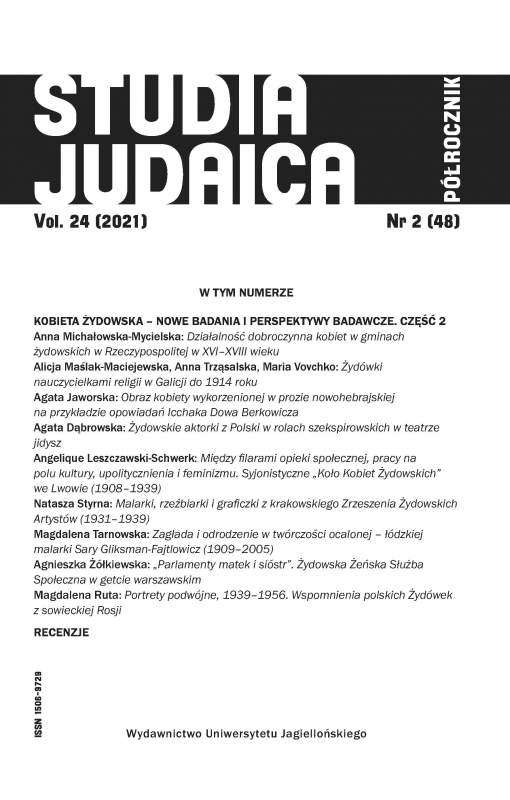Żydowskie aktorki z Polski w rolach szekspirowskich w teatrze jidysz
Jewish Actresses From Poland in Shakespearean Roles In the Yiddish Theater
Author(s): Agata DąbrowskaSubject(s): Theatre, Dance, Performing Arts, Fine Arts / Performing Arts, Jewish studies
Published by: Wydawnictwo Uniwersytetu Jagiellońskiego
Keywords: szekspirowskie; Burza; Hamlet; Kupiec wenecki; Szekspir; teatr jidysz; Shakespearean actresses; The Tempest; The Merchant of Venice; Shakespeare; Yiddish theater
Summary/Abstract: The article aims at analyzing the role played by Jewish actresses in the development of the Shakespearean Yiddish theater. The paper includes the profiles of artists coming from Poland and/or working in the Polish lands: Bertha Kalisch, Miriam Orleska, and Ester Goldenberg, who contributed to popularization of Shakespeare’s works among the Jewish community. Moreover, the article illustrates their contribution to the changes in the perception of Jewish theater from the “jargon drama” enterprise to an ambitious cultural institution with a Shakespearean repertoire. Among those discussed are the characters of Hamlet performed by Kalisch, Portia (The Merchant of Venice) played by Orleska, Jessica (The Merchant of Venice), and Ariel (The Tempest) interpreted by Goldenberg, and their assessment. The reception of these stage creations of Shakespearean heroes is analyzed on the basis of press materials published in daily newspapers and weeklies in Yiddish, Polish, and English. Some academic studies on the premieres of Hamlet, The Merchant of Venice, and The Tempest with participation of Jewish female artists have already been conducted, but their authors did not analyze the roles performed by those actresses and did not refer to the sources in Yiddish at all. The article discusses not only the artistic activities of Kalisch, Orleska, and Goldenberg, but also attempts to analyze the reception of the characters created by the latter two artists from the perspective of the social and political relations in the Second Polish Republic. Moreover, efforts were made to show that Jewish actresses, by impersonating heroines and heroes of Shakespeare’s plays, proved with their style of acting, professional preparation, and understanding of the nuances of the performed characters that Yiddish theater definitely deserved to be called a temple of art. Their creations became an inherent part of the history of Jewish, and thus the world’s Shakespearean theater.
Journal: Studia Judaica
- Issue Year: 24/2021
- Issue No: 48
- Page Range: 343-375
- Page Count: 33
- Language: Polish

